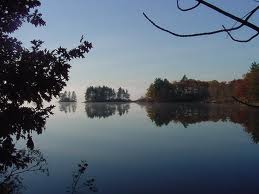Maine Lakes’ Health Reflected in the Color of Water

Pleasant Pond in Central Maine: Lakefront Views to Remember
May 10, 2012
Out and About for the Mid Coast Lakes Regions of Maine May 17-23
May 16, 2012Maine Lakes’ Health Reflected in the Color of Water

Take Time to Reflect at Lake Megunticook in Lincolnville, Maine
As you stand beside the lake on your waterfront property in Maine, ask yourself why it looks the way it does. If you cup some water in your hand, it appears colorless, but look at the body of water and it has a color. Yes, it does reflect the sky, but it’s the water’s depth and what’s happening down there that also gives it color. What does that color mean?
Laura Wilson of the University of Maine Cooperative Extension explains it this way:
Suspended and dissolved particles in water influence the color. The suspended material may be a result of natural causes and/or human activity.
Clear Blue Water has a low accumulation of dissolved material to reflect colors. The darker the blue, the deeper the water.
Translucent Water has less dissolved and suspended materials. If the water is very shallow, there isn’t enough depth for blue wavelengths of light to travel and reflect back.
Murky or Cloudy Water is caused by eroding soil. Strong winds stir up sediment and cause turbidity. In urban areas, this water may appear as a gray color.
Transparent but Brown Water that looks like tea or rootbeer is the result of decaying leaves or organic matter.
Green Water means there is excessive algal growth most frequently caused by excess nutrients or fertilizers.
Oily Sheen on the Water indicates that there might have been a petroleum spill. That oily look may also come from the breakdown of natural sources, e.g. some bacteria get their energy from iron and manganese–when these bacteria decompose they may appear oily, or slimy black, red or orange as the metals solidify.
(Note: To tell the difference between an oil spill and natural oil sheen–poke with a stick–If it swirls back together immediately, it’s petroleum. If it breaks apart, then it’s either bacterial or plant/animal decomposition.)
Yellowish Powder or Dust in spring/early summer, as you probably know, is pollen from evergreens and flowering trees.
Orange or Reddish Brown Slime on surface is caused by high iron concentrations and iron bacteria.
Ultimately, the color of the water and quality of a lake is a reflection of how we take care of its watershed. Healthy watersheds make healthy lakes and higher property values.
Natural shorelines full of trees and native plants form the foundation of a healthy lake. As a Maine lakefront property owner, you can help protect the water quality and natural beauty of your lake for yourself, your neighbors, and future generations.
To learn more about lakefront property listings on Megunticook Lake, just click on the green box above.
For More Information about Above Average Water Quality:
Great East Lake is Acton, Maine’s Golden Pond
Surveying the Watershed of Moose Pond in Bridgton, Denmark and Sweden, Maine
